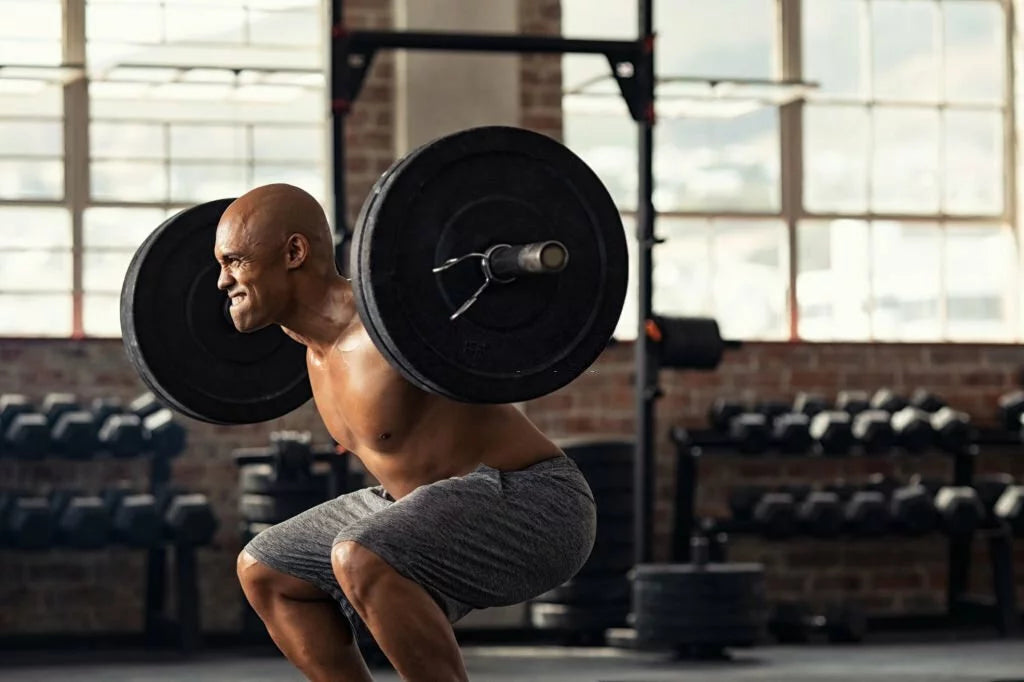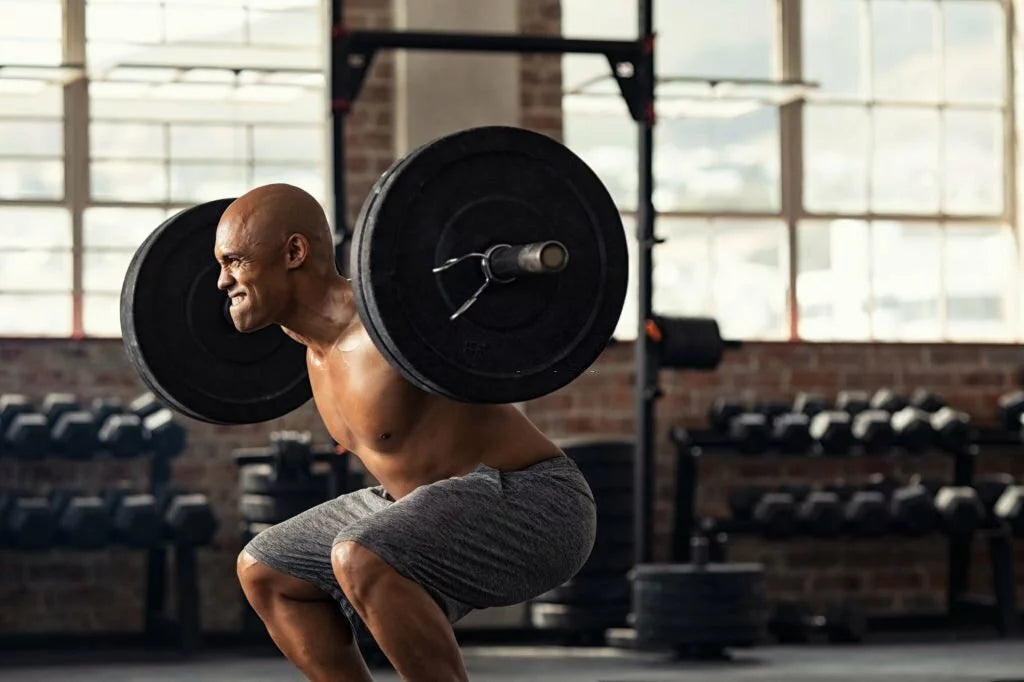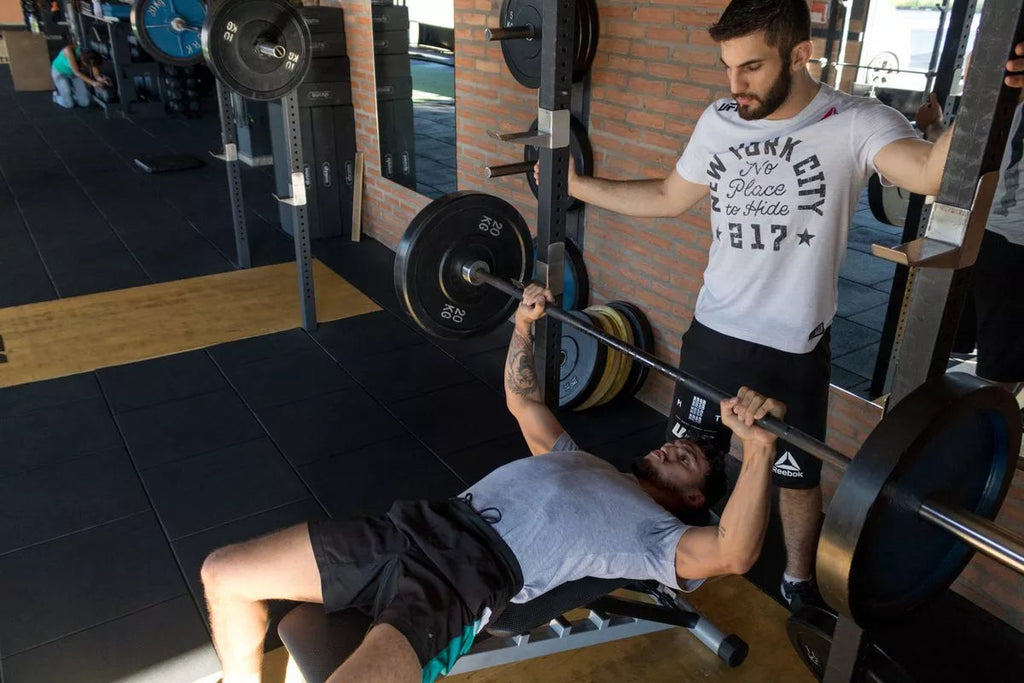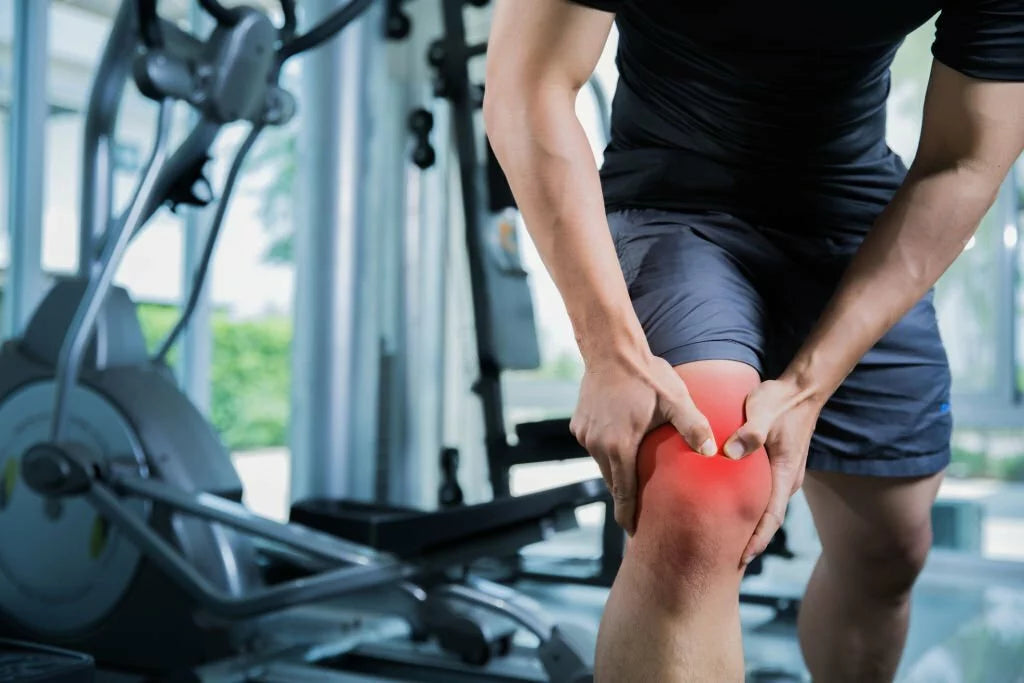Douleur au genou en position accroupie : causes, prévention et stratégies de traitement


Les douleurs au genou lors des squats sont fréquentes chez les personnes pratiquant des exercices de musculation. Les squats sont un exercice courant chez la quasi-totalité des athlètes, haltérophiles, culturistes et autres personnes actives physiquement, car ils sont très efficaces pour développer la force du bas du corps, la musculature et les qualités athlétiques en général .
Et puisque cet exercice ancestral pour le bas du corps est si efficace et bénéfique, il vaut la peine d'être pratiqué. Mais c'est plus facile à dire qu'à faire si vous ressentez une douleur ou une gêne au genou. Si votre genou vous fait mal en squat, pas d'inquiétude ; c'est un problème étonnamment courant chez de nombreux haltérophiles.
Les douleurs au genou dues aux squats sont souvent dues à la complexité du corps humain et à la technicité de l'exercice. De nombreux problèmes peuvent survenir au niveau du genou, rendant le mouvement douloureux à chaque tentative. En fait, beaucoup de choses peuvent mal tourner, et le droit à l'erreur est limité. Mais vous avez de la chance !
Dans cet article, je discuterai des causes courantes de douleurs au genou lors des squats et je fournirai mon expertise professionnelle en tant que physiothérapeute et spécialiste de la force et du conditionnement pour des moyens éprouvés de prévenir les douleurs au genou dues aux squats et couvrirai des stratégies de traitement efficaces pour vous aider à surmonter ce problème et à continuer votre programme de musculation en toute sécurité.
Causes de douleurs au genou lors des squats
Cela peut paraître étrange au commun des mortels, mais le squat est un mouvement étonnamment technique. Et même si le genou ressemble à une simple articulation qui se plie et se redresse, bien d'autres mécanismes interviennent sous la peau et à l'intérieur du corps lors de l'exécution du squat.
Par souci de simplicité, je vais décomposer les causes courantes de douleur au genou en deux catégories distinctes :
- Problèmes de technique de squat (mauvais contrôle des mouvements, positionnement du corps, etc.)
- Facteurs intrinsèques au niveau du genou et des tissus environnants.
Pour être clair, l'une ou l'autre de ces deux catégories produira une douleur dans votre genou pendant les squats, mais les solutions pour vous débarrasser de votre douleur au genou seront totalement différentes en fonction de la cause du problème sous-jacent.
Commençons par la technique et la posture nécessaires pour préserver la santé de vos genoux et éviter tout problème. J'examinerai ensuite les problèmes courants qui peuvent survenir au niveau de l'articulation du genou.
[En lien avec : Bruits de genou : claquement de genou lors de l'accroupissement | Bon ou mauvais ? ]
Forme et technique de squat incorrectes
Bien qu'un article entier puisse être consacré à l'optimisation, au perfectionnement et à la personnalisation de votre technique de squat, cela dépasse le cadre de cet article. Voici les aspects fondamentaux à prendre en compte et à mettre en œuvre pour tout haltérophile ou athlète souhaitant préserver la sécurité et la douceur de ses genoux pendant le squat.
Optimiser votre position de squat pour améliorer la mécanique du genou
L'aspect le plus important à comprendre avec la technique du squat est que, bien qu'il existe des directives générales à suivre, chaque haltérophile devra expérimenter en affinant sa position de squat pour déterminer ce qui convient le mieux à ses genoux.
Deux facteurs principaux doivent être pris en compte pour votre position de squat :
- La largeur de votre position (la distance entre vos pieds) ;
- Le degré d'orteil ou d'« évasement » que vous avez (si vos orteils pointent directement vers l'avant ou légèrement vers l'extérieur).
Malgré ce que d'autres pourraient préconiser, adopter une approche strictement dogmatique concernant la largeur de la position et le positionnement des orteils n'est pas idéal. C'est comme dire que tout le monde devrait avoir exactement le même régime alimentaire ; nos structures squelettiques sont suffisamment différentes pour que ce qui fonctionne pour un pratiquant puisse ne pas fonctionner pour un autre. La bonne technique de squat peut être un concept très individuel.
La modification de l’un ou l’autre de ces facteurs peut modifier radicalement la biomécanique du genou, influençant votre douleur au genou pour le meilleur ou pour le pire.
En règle générale, votre position de squat doit être à peu près à la largeur des épaules, et une légère inclinaison des orteils vers l'extérieur vous permettra d'atteindre la position la plus courante. Mais n'hésitez pas à jouer avec ces facteurs.
Un point supplémentaire à prendre en compte : ne laissez pas vos talons décoller du sol lorsque vous vous accroupissez – cela exercerait une pression inutile sur l'avant du genou, y compris le tendon du quadriceps et le tendon rotulien.
Assurer un suivi parfait du genou
Adopter une position de squat idéale n'est que la moitié du travail ; l'autre moitié consiste à maintenir vos genoux dans un alignement parfait tout au long du mouvement. Après tout, une position de squat parfaite ne préviendra pas les problèmes de genoux si ceux-ci se déplacent mal pendant l'exercice.
Dans cet article, le « suivi du genou » désigne le fait d'empêcher vos genoux de s'affaisser ou de s'affaisser vers l'intérieur, ce que l'on appelle une position de genou valgus. Vous entendrez souvent les haltérophiles parler du suivi du genou comme du maintien d'une position « empilée » ou d'un « alignement » idéal.
Votre objectif tout au long du squat est de maintenir chaque genou aligné directement au-dessus du dessus de son pied respectif. Si vos genoux s'affaissent (une erreur fréquente en squat), ils ne seront plus alignés directement au-dessus, ce qui engendrera une torsion et une tension importantes au niveau de l'articulation du genou.
Trouver la profondeur de squat idéale
Un aspect souvent négligé du squat sans douleur est la profondeur à laquelle il est effectué. Bien que s'accroupir sur toute l'amplitude (squats profonds) puisse présenter certains avantages pour l'entraînement, il se peut que vos genoux ne supportent pas une telle amplitude de mouvement (appelée flexion du genou), surtout avec des charges lourdes. Des amplitudes de mouvement plus importantes pendant le squat peuvent provoquer des douleurs au genou chez les haltérophiles souffrant de problèmes tendineux (abordés plus loin dans l'article) ou ayant déjà subi des blessures au genou.
Par conséquent, vous devrez prendre le temps d’expérimenter la profondeur de squat optimale pour déterminer ce qui convient le mieux à vos genoux.
Affections orthopédiques survenant au niveau du genou
Après avoir abordé les douleurs au genou liées à la technique, examinons maintenant les causes spécifiques de la douleur au genou lors du squat. Le genou est composé de nombreuses structures et tissus, ce qui peut engendrer de nombreux problèmes. Bien que je ne puisse pas aborder toutes les affections du genou, je vais aborder les problèmes les plus fréquents qui peuvent affecter les genoux douloureux lors du squat.
Déséquilibres musculaires au niveau de la cuisse
La cuisse (partie avant de la jambe) comporte de nombreux muscles. Pour que le genou puisse bouger de manière optimale et sans douleur, un équilibre entre force et mobilité est nécessaire pour chacun d'eux. Il est très fréquent que certains muscles de la cuisse deviennent plus forts ou plus faibles que leurs homologues, ce qu'on appelle souvent un déséquilibre musculaire . L'objectif est de maintenir la force et la mobilité de chaque muscle traversant l'avant du genou, ce qui contribue à optimiser le mouvement et la fonction du genou.
Comparez cela aux pneus de votre véhicule : si certains sont sous-gonflés et d'autres surgonflés, cela entraînera des problèmes de direction et d'alignement lors de la conduite, voire une usure anormale des pneus. Le même principe s'applique à la mobilité du genou en position accroupie : si votre rotule ne peut pas se déplacer correctement en raison d'une tension musculaire anormale, cela peut entraîner des problèmes tels que le syndrome douloureux fémoro-patellaire (SDFP), où le cartilage et les tissus environnants de la rotule deviennent irrités et douloureux.
Problèmes de mobilité au niveau des chevilles ou des hanches
Une mobilité limitée des chevilles ou des hanches peut exercer une pression excessive sur les genoux lors des squats. Lorsque les chevilles ou les hanches ne sont pas suffisamment mobiles pour effectuer toute leur amplitude de mouvement, des mouvements compensatoires peuvent se produire au niveau du genou, ce qui peut provoquer une gêne ou une douleur au genou pendant le squat. Des exercices de mobilité des chevilles et des hanches, conçus pour cibler et améliorer les mouvements restreints, peuvent contribuer à améliorer l'amplitude de mouvement de la cheville et à soulager les douleurs au genou.
Arthrose du genou et arthrite du genou
Comme toute autre partie du corps, le genou est sujet à l'usure ou aux fractures au fil du temps. Ces fractures peuvent survenir de multiples façons, et la maladie dégénérative du genou la plus courante est l'arthrose. Elle désigne la dégradation du cartilage situé à l'extrémité du fémur et du tibia, là où ces surfaces articulaires interagissent.
Lorsque cette dégradation se produit, le genou devient souvent douloureux lors des mouvements (car le cartilage n'est plus lisse) ou lors des mouvements contre une résistance plus forte puisque l'articulation malade est alors comprimée.
Les squats peuvent donc être très douloureux pour les genoux arthritiques. L'intensité et le moment d'apparition de la douleur dépendent en grande partie de l'ampleur des modifications arthritiques du genou.
Tendinite rotulienne et bursite du genou
Les tendons et les bourses séreuses sont deux tissus spécialisés qui contribuent au fonctionnement efficace et indolore du corps. Un tendon est un morceau de tissu qui ancre l'extrémité d'un muscle à un os. Une bourse séreuse est une petite poche remplie de liquide qui contribue à réduire les frottements articulaires en permettant aux tendons et autres structures similaires de glisser sans irritation.
Le corps est constitué de centaines de tendons et de bourses séreuses, dont le genou en contient quelques-uns essentiels à la santé et à l'absence de douleur. Les deux tendons les plus sensibles sont le tendon rotulien et le tendon quadricipital. Cela peut entraîner des affections douloureuses appelées tendinites ou tendinoses.
En ce qui concerne les bourses, la bourse pré-rotulienne et la bourse de l'ansérine peuvent souvent devenir irritées et douloureuses, ce qui entraîne une affection appelée bursite (inflammation de la bourse).
Ces deux problèmes, bien que courants, peuvent parfois être difficiles à résoudre sans l’avis d’un professionnel de la santé qualifié. Demandez donc conseil à un professionnel qualifié si vous pensez que votre douleur au genou est due à l’un de ces problèmes.
Blessures antérieures affectant la fonction du genou
Les blessures antérieures au genou entraînent souvent des mouvements dysfonctionnels et douloureux. Les raisons de ce phénomène dépassent largement le cadre de cet article. Il est néanmoins important de savoir que les blessures peuvent altérer la mobilité de l'articulation du genou, voire l'empêcher de bouger. Et, comme vous le savez probablement, une altération du mouvement ou de la fonction peut provoquer des douleurs au genou.
Bien que le genou puisse subir un nombre presque infini de blessures conduisant à cette situation, les blessures impliquant le ménisque sont sans doute les plus courantes.
Le ménisque est un anneau de fibrocartilage situé entre les articulations du genou. Chaque genou possède deux de ces structures absorbant les chocs, essentielles à sa santé optimale. Une déchirure (traumatique) ou une dégénérescence du ménisque (liée à l'âge) peuvent entraîner des modifications mécaniques du genou, souvent très douloureuses, provoquant des sensations aiguës de pincement lors de la flexion ou de l'extension du genou.
Si vous pensez avoir une déchirure du ménisque ou une autre blessure au genou, il est essentiel de consulter un spécialiste en médecine du sport ou un chirurgien orthopédiste pour un diagnostic et un traitement appropriés.
Stratégies de prévention et de traitement de la douleur au genou
Une approche globale est nécessaire pour prévenir ou soulager les douleurs au genou lors des squats. Explorons quelques stratégies efficaces de prévention et de traitement :
Exercices de renforcement des muscles des cuisses et des déséquilibres musculaires
Cibler les quadriceps et corriger les déséquilibres musculaires est essentiel pour prévenir les douleurs au genou. Divers exercices pour les quadriceps et le tendon rotulien peuvent contribuer à renforcer ces muscles et à stabiliser l'articulation du genou. De plus, des exercices de renforcement musculaire général des cuisses, comme les squats sans poids ou les fentes, peuvent contribuer à corriger les déséquilibres musculaires.
Forme et technique de squat appropriées
De nombreux patients, athlètes et sportifs que je soigne et avec lesquels je travaille sont surpris de constater à quel point les douleurs persistantes ou gênantes au genou qu'ils ressentent en squat peuvent être considérablement réduites, voire éliminées, en améliorant leur technique. De légers changements de positionnement peuvent avoir des effets profonds sur la mécanique et la douleur du genou.
Adopter une posture et une technique appropriées est essentiel pour prévenir les douleurs aux genoux lors des squats. Prenez le temps de vous assurer que votre technique est parfaitement au point. Que vous vous filmiez et regardiez votre performance ou que vous fassiez appel à un entraîneur, faites le nécessaire pour réaliser des squats avec une technique parfaitement adaptée aux besoins de votre corps.
Exercices de mobilité de la cheville et de la hanche
Améliorer la mobilité de la cheville et de la hanche est essentiel pour prévenir les douleurs au genou lors des squats. Intégrer régulièrement des mouvements et des exercices de mobilité peut améliorer l'amplitude de mouvement de la cheville et de la hanche, réduisant ainsi les mouvements compensatoires du genou lors des squats. Si vous savez que votre cheville ou votre hanche ne bouge pas autant qu'elle le devrait, efforcez-vous de corriger toute limitation de mouvement, car une raideur articulaire au-dessus ou en dessous du genou peut influencer la mobilité de votre genou pendant le squat, entraînant souvent des douleurs.
Interventions de physiothérapie
La kinésithérapie peut être extrêmement bénéfique pour les personnes souffrant de douleurs au genou lors des squats. Un kinésithérapeute peut prescrire des exercices, des mouvements et des étirements spécifiques, adaptés à vos besoins. Il peut également vous aider à soulager votre douleur et à atténuer ou résoudre le problème sous-jacent grâce à des modalités thérapeutiques spécifiques et des techniques manuelles. Il peut également vous aider à savoir quand consulter un médecin et collaborer avec lui pour des interventions complémentaires.
Considérations supplémentaires pour s'accroupir avec une douleur au genou
En plus des stratégies de prévention et de traitement mentionnées ci-dessus, voici quelques considérations supplémentaires à garder à l’esprit lorsque vous vous accroupissez avec une douleur au genou :
Échauffement et préparation des tissus appropriés
Un échauffement complet et une mobilisation des tissus du genou peuvent réduire le risque de blessure et soulager les douleurs. Voici une séquence d'échauffement idéale pour soulager vos genoux avant une séance de squat :
- Cardio d’intensité légère (comme faire du vélo) pendant cinq minutes.
- Une séquence d’étirements dynamiques pour les muscles de vos jambes.
- Mobilisation des tissus autour de votre genou, comme une séance rapide de roulement en mousse de vos quadriceps, de votre bandelette ilio-tibiale et de vos mollets.
Une brève séquence d’échauffement comme celle-ci contribuera grandement à garantir que vos genoux bougent bien et sont préparés pour votre prochain entraînement de squat.
En guise de stratégie supplémentaire, vous pouvez envisager de porter des genouillères lors des squats, car elles aident à conserver la chaleur à l'intérieur et autour du genou pendant l'entraînement. De nombreux haltérophiles (dont moi-même) trouvent cette stratégie utile et agréable pour les genoux.
Modifications de l'intensité et du volume de l'exercice
Si vous ressentez des douleurs au genou lors des squats, il peut être nécessaire de modifier l'intensité et le volume de vos entraînements. Le volume correspond à la quantité totale d'efforts fournis lors de votre séance. Vous pouvez calculer votre volume d'entraînement et l'ajuster en conséquence si nécessaire.
Volume = séries x répétitions x poids soulevé
Réduire le poids, le nombre de répétitions ou le nombre de séries diminuera le volume de votre entraînement et soulagera la tension exercée sur vos genoux tout en vous permettant de continuer à vous entraîner en force. Augmenter progressivement l'intensité à mesure que la douleur au genou s'atténue est essentiel pour éviter une nouvelle blessure.
Variations alternatives de squat pour réduire l'inconfort du genou
Parfois, le genou ne supporte tout simplement pas les squats. Presque tous les haltérophiles traversent ce genre de période au moins une fois dans leur carrière. J'en ai moi-même fait l'expérience à maintes reprises au cours de mes années d'haltérophilie. Si vous êtes dans cette période, pas d'inquiétude : il existe de nombreux autres exercices pour les jambes très bénéfiques que vous pouvez essayer et qui pourraient convenir à votre genou.
Prenez le temps d'explorer d'autres exercices pour les jambes ou des variantes de squat. De nombreuses ressources en ligne vous permettront d'élargir vos horizons en vous montrant de nouvelles façons de travailler et de renforcer le bas du corps sans vous fatiguer les genoux.
Importance du repos et de la récupération en cas de douleur chronique au genou
Que vos genoux soient sains ou douloureux, un repos et une récupération adéquats doivent toujours être une priorité. Cependant, si vous ressentez une douleur aiguë (nouvelle) ou chronique (douleur persistante) au genou lors des squats, vous devez redoubler d'attention à tous les aspects de votre repos et de votre récupération. Continuer à s'entraîner malgré une douleur persistante au genou peut aggraver le problème et entraîner d'autres complications .
Pour commencer, vous devrez prendre en compte :
- Assurer le volume d’entraînement idéal (séries, répétitions et poids) utilisé pour vos squats ;
- Un temps de récupération adéquat avant votre prochaine séance de squat ou d’entraînement du bas du corps, probablement pas plus tôt que 72 heures après votre précédente séance de squat ;
- Adaptez votre alimentation en vous assurant de consommer suffisamment de macronutriments (lipides, protéines et glucides) et de micronutriments (vitamines et minéraux) pour aider votre corps à construire et à réparer les tissus douloureux ou irrités ;
- Privilégiez les tactiques de récupération et de refroidissement telles que le roulement de mousse, les exercices de mobilité et les massages.
Chacun de ces points peut être un pas dans la bonne direction pour vous assurer de ne pas surcharger votre genou d'une manière qui provoque de la douleur ou de l'inconfort tout en garantissant qu'il a les meilleures chances possibles de se remettre de tout stress ou tension qu'il pourrait subir.
Conclusion
Les douleurs au genou lors des squats peuvent constituer un obstacle majeur à la musculation. Comprendre les causes, les stratégies de prévention et les options de traitement est essentiel pour surmonter ce problème et poursuivre votre parcours de remise en forme en toute sécurité. En corrigeant les déséquilibres musculaires, en améliorant la technique et la posture au squat, en améliorant la mobilité de la cheville et en sollicitant l'aide et les conseils d'un professionnel, vous pouvez prévenir les douleurs au genou, promouvoir des pratiques de squat sûres et atteindre efficacement vos objectifs de musculation.
N'oubliez pas qu'il est essentiel d'écouter votre corps et de consulter un médecin si la douleur au genou persiste ou s'aggrave malgré vos efforts. Restez motivé, faites les ajustements nécessaires et profitez d'une séance de squat sans douleur.


